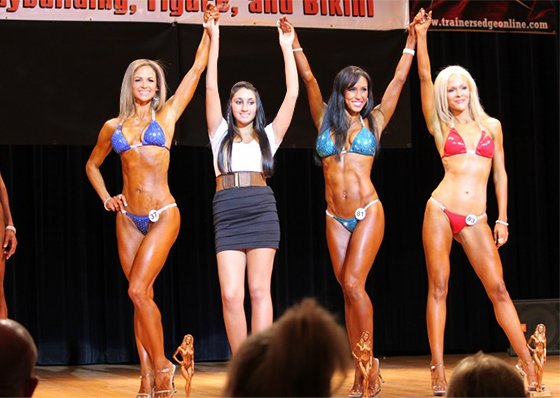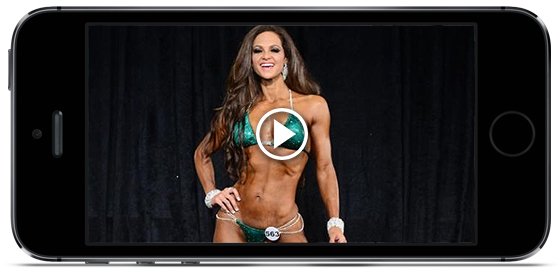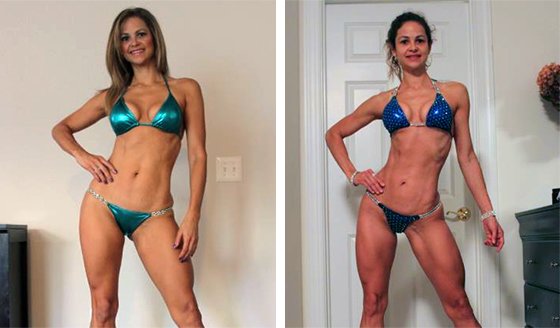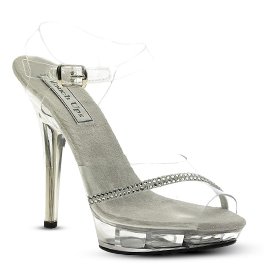I had no idea what I was getting myself into when I decided to compete. I was a 33-year-old mother of two struggling to lose my pregnancy weight. I was unhappy with my decision to end the career I'd spent a lifetime planning. I felt somewhat lost and reluctantly accepted that my daily life would consist of childcare, keeping house, supporting my husband while he pursued his medical residency, and struggling to lose weight.
This sounds crazy, but I actually learned about fitness competitions through my hobby of couponing! While sitting on my couch, flipping through a free issue of "Muscle & Fitness Hers," I saw a page with mothers who had undergone physical transformations and achieved competition-worthy physiques. I knew I found my challenge—and my calling.
First Steps
In photos, competing looked fun, easy, and glamorous, but when the day came for me to slip into a tiny suit and sky-high heels, and stand in front of Gary Udit—one of the best Pro and National Judges and posing coaches in the nation—I was a complete wreck. I quickly understood the importance of stage presence and posing.
The day I met Gary was the first time anyone had seen me in my competition suit and heels. I remember walking through the gym, clutching my cover-up, embarrassed that my fellow gym-goers were watching me teeter in 6-inch heels.

While Gary was warm and welcoming, my first posing session didn't go as I'd imagined. There wasn't any music or glitz; it was just Gary and me in a room lit by revealing fluorescent lights and covered in mirrors. I presented my prepared routine using the stances I had seen in videos. The floor was carpeted, unlike the hardwood floors I was used to practicing on. I lost my balance several times, my heel caught in the flooring, and any attempt at a smile caused my lips to quiver. I remember thinking: What am I doing? If I'm this nervous now, how can I do this in front of a huge audience?
By the end of my initial 30-minute posing session with Gary, I'd seen the strengths and weaknesses of my physique and learned what poses work best for my body. I'd gained more confidence in that tiny suit, and I had been briefed on the stage and venue. Basically, I learned what to expect the day of the competition—something I would have never gotten from Internet searches alone.
Put my experience to work for you! Follow these five insider competition tips and you'll be ready to tackle your first show, minus the stumbling in heels.
1
Hire A Reputable Coach
As a competitor, you go through months of strenuous training and dieting to get your body stage-ready. Despite being physically ready, you have to know how to present your individual physique to showcase your strengths and conceal your weaknesses. While there are mandatory poses within each division, many details can be adjusted to make your presentation stronger. A great posing coach can evaluate your physique and—with the subtle switch of foot position, twist of the torso, or tilt of the pelvis—create lines and shape to emphasize muscles that can mean the difference between nabbing first place and being stuck in the crowd.
Hire a posing coach to evaluate your physique and show you how to pose correctly to make the most of your hard work. Every competitor should have at least one session with a posing coach. However, I recommend continued sessions throughout competition prep as your physique changes.
In my case, my legs were too big and muscular in the beginning, so I needed to pose in a variation of the basic front pose in order to downplay their size and give the illusion of a more balanced physique. However, as my legs became tighter and smaller, I was able to change my stances and eliminate poses where my legs now looked too skinny. Had I only seen a posing coach during the beginning of my prep, I would have gone on stage with stances that did not present my physique in the best possible way.

2
Videotape Your Sessions
Mirrors are nice, but video is your best friend. How you present yourself on stage can have a huge influence on your placing. Do you smile and move gracefully through your poses, or do you look like a deer caught in headlights? Stage presence is as much confidence as it is grace. Every competitor on stage has a remarkable physique, but placing in the top positions means bringing a complete package. This is where consistently practicing and taping your routines can make all the difference.
First, pose with mirrors to see how each pose looks and feels. Once you consistently hit your poses without much correction, trade in your mirror for a video camera. Why? You won't become dependent on looking at your reflection while posing, and video playback will still allow you to check your form. Eventually you'll learn how to adjust your body based on how poses feel, not how they look.

The first time I videotaped my routine, I had a preconceived idea of how I looked. Boy was I wrong! The way I walked looked completely different than it felt; I made facial expressions I didn't even know I could make; and certain stances I thought were perfect revealed my skin folds, which is not aesthetically pleasing. Finally, I saw what the judges would see. Videotaping made all the difference. Here's a tip: Watch tapes of competitors' presentations, compare them to yours, and mimic those you like. Small details can make a big difference!
3
Focus On Timing—and Breathe
Practicing your routine as much as possible will allow you to perform it on stage without hesitation. Efficiently transitioning between the mandatory poses not only creates a polished and flawless presentation, it also allows more time to hold each mandatory pose. This becomes extremely important when considering the limited window you have to present months of hard work and training.
For this reason, it's so important to time your routine. Most competitions will only allot you approximately 10 seconds to complete your presentation. This equals roughly two seconds per pose if you present four poses and allow time for transitions. When you're on stage, you need to be able to get into your poses and "feel" how long you hold them so you don't run the risk of falling short on time and failing your routine.

A great trick to keep track of timing during your presentation, without having to count, is through breathing. Taking a deep breath in takes roughly one second to complete, while breathing out takes about two seconds. When holding a mandatory pose, I simply breathe out for two seconds, transition while taking a quick breath, and then hit my next mandatory pose while breathing out. In addition to helping keep time, the deep breath out ensures I tighten my core. It also prevents me from holding my breath—a move many competitors resort to that causes them to appear miserable.
4
Simulate The Big Day
The saying "knowledge is power" could not be truer on competition day. Learn as much as you can about the competition venue. Attend a competition at the location beforehand to allow you to see how large the stage and audience are, so you will know what to expect when you first walk out. If you anticipate a small stage and audience but walk out onto a long stage with an open audience, it can be intimidating.
Also, think about what will be beneath your feet. Know whether the floor you present on is wood or carpet; that will give you a leg up. Routines which use pivots to turn can work well on hardwood floors but spell disaster on carpet. Regardless of the flooring, be sure to rehearse your routine in your shoes and suit.

The first time I competed, I'd only worn my heels during short practices. The day of the competition, I had to wear them significantly longer. Before I even stepped on stage, my feet hurt and I walked differently because of the pain and fatigue. I learned a valuable lesson that day. Now, several weeks prior to competition, I begin wearing my heels around the house and add padding to alleviate pain. The less discomfort I feel on stage, the less I worry about wobbling, losing my balance, or tripping.
Also, be sure to tune in. Practicing to your music—or the type of music that will be played for your division—will get you used to the energy level created by the tempo of a song. If you practice in silence, the sudden energy of competition day and the upbeat music can result in overcompensating and adding too much flare and movement to your routine.
Finally, nothing boosts confidence like having friends in the audience cheer you on. Hearing the roar of familiar voices as you walk across the stage can quiet any negative thoughts in your head, lead to a genuine smile, and make you an eye-catching, confident competitor.
5
Know Your Judges
This is my greatest "insider" tip. Know who will be judging at your event, and who the head judge will be; this can be an invaluable tool. Judging can be entirely subjective. While one judge may prefer a softer more feminine physique with a more flirtatious look and more movement, another judge may prefer a harder physique with slightly more visible musculature and a more professional routine. If you're serious about competing, know your judges and their preferences. Ask via word-of-mouth, or view the galleries and videos of past winners to give you a hint.

